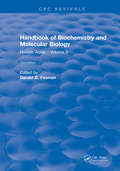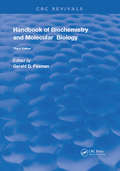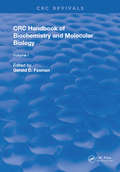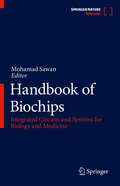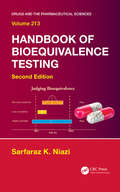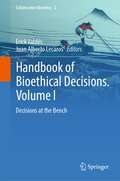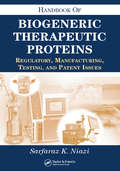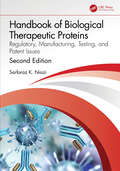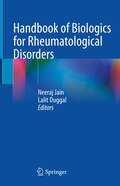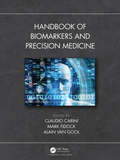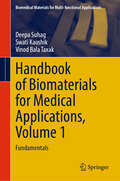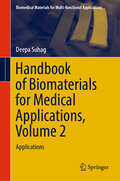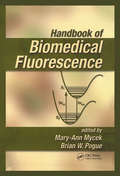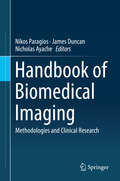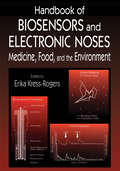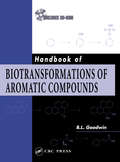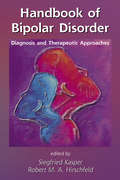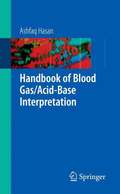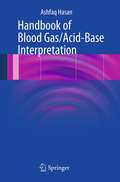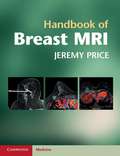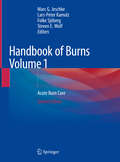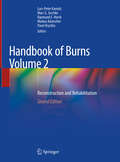- Table View
- List View
Handbook of Biochemistry: Section B Nucleic Acids, Volume II (Routledge Revivals Ser.)
by Gerald D FasmanThe section of this handbook has been dividing into two volumes, the first volume contains information relating to purines, pyrimidine and nucleoside, oligonucleotide, polynucleotides, and their derivatives. Both ribo and deoxyribo compounds are listed also. The second volume will contain the remaining material similar to Volume 1 and material more relative to genetic and biological aspects such as enzymes involved in nucleic acid function, protein synthesis, linkage maps.
Handbook of Biochemistry: Section C Lipids Carbohydrates & Steroids, Volume l (Routledge Revivals Ser.)
by Gerald D FasmanThis first volume contains data on amino acids which consists of the coefficients of solubility in water, heat capacities, entropies of formation, and heats of combustion. Specific gravity liquids, sucrose solution, CsCI solution isokinetic glycerol and sucrose gradients for density gradient centrifugation and the temperature dependence for select compounds are included.
Handbook of Biochemistry: Section D Physical Chemical Data, Volume I (Routledge Revivals Ser.)
by Gerald D FasmanThis first volume contains data on amino acids which consists of the coefficients of solubility in water, heat capacities, entropies of formation, and heats of combustion. Specific gravity liquids, sucrose solution, CsCI solution isokinetic glycerol and sucrose gradients for density gradient centrifugation and the temperature dependence for select compounds are included.
Handbook of Biochips: Integrated Circuits and Systems for Biology and Medicine
by Mohamad SawanThis book provides a broad survey of the field of biochips, including fundamentals of microelectronics and biomaterials interaction with various, living tissues, as well as numerous, diverse applications. Although a wide variety of biochips will be described, there will be a focus on those at the brain-machine interface. Analysis is included of the relationship between different categories of biochips and their interactions with the body and coverage includes wireless remote control of biochips and arrays of microelectrodes, based on new biomaterials.
Handbook of Bioequivalence Testing (Drugs and the Pharmaceutical Sciences)
by Sarfaraz K. NiaziAs the generic pharmaceutical industry continues to grow and thrive, so does the need to conduct adequate, efficient bioequivalence studies. In recent years, there have been significant changes to the statistical models for evaluating bioequivalence. In addition, advances in the analytical technology used to detect drug and metabolite levels have m
Handbook of Bioethical Decisions. Volume I: Decisions at the Bench (Collaborative Bioethics #2)
by Erick Valdés Juan Alberto LecarosThe Handbook of Bioethical Decisions is aimed at addressing and analyzing the most important ethical concerns and moral quandaries arisen in biomedical and scientific research. As such, it identifies and problematizes on a comprehensive range of ethical issues researchers must deal with in different critical contexts. Thus, the Handbook, Vol. I, may be helpful for them to make decisions and deliberate in complex practical scenarios. In this fashion, the volume reunites different points of view to give readers room enough to get a better knowledge and take their own position on pressing bioethical issues of the day. Consequently, this work seeks to engender dense ethical epistemology scientists can count on when conducting latest generation biomedical research. By bringing together an impressive array of contributions on the most important elements and categories for “at the bench” bioethical decisions as well as offering chapters by some of the most world renowned and prominent experts in bioethics, the Handbook, Vol. I, is a paradigmatic text in its area and a valuable resource for courses on bioethics, and biomedical research, as well as courses that discuss ethics and the biosciences at different professional levels, biomedical industry, pharmacological companies and the public sphere in general.
Handbook of Bioethical Decisions. Volume II: Scientific Integrity and Institutional Ethics (Collaborative Bioethics #3)
by Erick Valdés Juan Alberto LecarosThe Handbook of Bioethical Decisions Volume II addresses and analyzes the most important ethical concerns and moral quandaries related to scientific integrity and institutional ethics. It counts on two parts, Part One: Research Ethics, which addresses issues related to Scientific Integrity, Research Misconduct and Conducting Ethical Research, and Part Two: Institutional Ethics and Bioethics Committees, which explores Institutional Ethics issues, Ethics and Bioethics Committees’ roles and scopes, and Bioethical Issues in Institutional Ethics. Consequently, the Handbook, Vol. II, offers a remarkable collection of works by outstanding international experts on institutional and research ethics, in order for bioethics practitioners to obtain better elements to address key issues related to integrity in research as well as to decision-making processes. In this fashion, this volume is a valuable resource for professionals working on different bioethical and biomedical fields, such as, ethics and bioethics committees, health care institutions, biomedical and pharmacological companies, and academic settings, among others.Chapter 26 is available open access under a Creative Commons Attribution 4.0 International License via link.springer.com.
Handbook of Biogeneric Therapeutic Proteins: Regulatory, Manufacturing, Testing, and Patent Issues
by Sarfaraz K. NiaziMore than 20 billion dollars worth of biopharmaceuticals are scheduled to go off-patent by 2006. Given the strong political impetus and the development of technological tools that can answer the questions regulatory authorities may raise, it is inevitable that the FDA and EMEA will allow biogeneric or biosimilar products. Even with all the regulato
Handbook of Biological Therapeutic Proteins: Regulatory, Manufacturing, Testing, and Patent Issues
by Sarfaraz NiaziSince 1972, which marks the invention of recombinant engineering, more than 500 therapeutic proteins have been approved for clinical use. Today, biological drugs constitute almost 70% of all new drugs and have a biological origin. The first edition of this book dealt with biosimilars, and this edition (i.e., the second edition) focuses on new drugs, yet limits to therapeutic proteins. Newer technologies for drug development represent the updated topics in the book and include repur-posing, AI- driven identification of newer designs, novel expression systems, manufacturing using these systems, rapidly changing regulatory pathways, and legal hurdles. This edition discusses how to identify, develop, manufacture, and take multibillion dollar products to market within the shortest possible time. Features: Complete and thorough coverage of the regulatory and technological challenges of developing generic therapeutic proteins Comprehensive, discovery to market, newer technologies, regulatory planning and IP hurdles are included that are not found elsewhere Expanded volume that must be in the hands of every company interested in biological drugs, including the mRNA-based biopharmaceutical companies fast appearing on the market Discusses how to identify, develop, manufacture, and take multibillion dollar products to market in the shortest possible time Renowned author and entrepreneur in the field of drug discovery and production
Handbook of Biologics for Rheumatological Disorders
by Neeraj Jain Lalit DuggalBiologics have revolutionized the treatment of autoimmune diseases due to their efficacy, speed of onset, and tolerability. The development of new agents and expanded use of existing agents continues to be a highly active area of investigation among rheumatic diseases, with a multitude of innovative therapeutic strategies in various stages of development. Although the story of treatments continues rapidly, therapeutic research in some conditions is hindered by the rarity of the disease, variation in phenotype, and concerns about toxicity. This fast-paced development of therapeutics,necessitates immediate evaluation of individual biologic agents and their best use in the new treatment regimens.This book provides an inclusive approach with the existing evidence concerning effectiveness and implications on the usage of biologics in treating various rheumatologic disorders. It also covers the evidence behind the rational use of these agents in varied autoimmune diseases. This manual also offers a complete overview of the existing & futuristic biologic treatments, and draws recommendations on how to standardize the most suitable regimen for a specific patient in the context of current guidelines. The handbook of Biologics in Rheumatology serves as a present and concise compendium to the modern therapeutic developments in the field.This book is likely to benefit clinicians, residents, fellow and other healthcare workers dealing with rheumatological disorders, and also hard-core Rheumatologists, who are looking for a quick recap of Biologics of their interest.
Handbook of Biomarkers and Precision Medicine
by Claudio Carini Mark Fidock Alain Van Gool"The field of Biomarkers and Precision Medicine in drug development is rapidly evolving and this book presents a snapshot of exciting new approaches. By presenting a wide range of biomarker applications, discussed by knowledgeable and experienced scientists, readers will develop an appreciation of the scope and breadth of biomarker knowledge and find examples that will help them in their own work." -Maria Freire, Foundation for the National Institutes of Health Handbook of Biomarkers and Precision Medicine provides comprehensive insights into biomarker discovery and development which has driven the new era of Precision Medicine. A wide variety of renowned experts from government, academia, teaching hospitals, biotechnology and pharmaceutical companies share best practices, examples and exciting new developments. The handbook aims to provide in-depth knowledge to research scientists, students and decision makers engaged in Biomarker and Precision Medicine-centric drug development. Features: Detailed insights into biomarker discovery, validation and diagnostic development with implementation strategies Lessons-learned from successful Precision Medicine case studies A variety of exciting and emerging biomarker technologies The next frontiers and future challenges of biomarkers in Precision Medicine Claudio Carini, Mark Fidock and Alain van Gool are internationally recognized as scientific leaders in Biomarkers and Precision Medicine. They have worked for decades in academia and pharmaceutical industry in EU, USA and Asia. Currently, Dr. Carini is Honorary Faculty at Kings’s College School of Medicine, London, UK. Dr. Fidock is Vice President of Precision Medicine Laboratories at AstraZeneca, Cambridge, UK. Prof.dr. van Gool is Head Translational Metabolic Laboratory at Radboud university medical school, Nijmegen, NL.
Handbook of Biomaterial Properties
by Jonathan Black William Murphy Garth HastingsThis book provides tabular and text data relating to normal and diseased tissue materials and materials used in medical devices. Comprehensive and practical for students, researchers, engineers, and practicing physicians who use implants, this book considers the materials aspects of both implantable materials and natural tissues and fluids. Examples of materials and topics covered include titanium, elastomers, degradable biomaterials, composites, scaffold materials for tissue engineering, dental implants, sterilization effects on material properties, metallic alloys, and much more. Each chapter author considers the intrinsic and interactive properties of biomaterials, as well as their appropriate applications and historical contexts. Now in an updated second edition, this book also contains two new chapters on the cornea and on vocal folds, as well as updated insights, data, and citations for several chapters.
Handbook of Biomaterials for Medical Applications, Volume 1: Fundamentals (Biomedical Materials for Multi-functional Applications)
by Deepa Suhag Swati Kaushik Vinod Bala Taxak"Handbook on Biomaterials for Medical Applications: Fundamentals" is a critical monograph that merges advanced technological insights with practical applications in biomedical materials science. It navigates through the intricate blend of theoretical knowledge and real-world medical practices, highlighting the significant roles these materials play in enhancing therapeutic outcomes. Addressing the interdisciplinary nature of the field, the book incorporates perspectives from chemistry, biology, engineering, and clinical medicine. This comprehensive guide covers novel biomaterials, advanced drug delivery systems, innovative tissue engineering, and the emerging field of theranostics, providing a holistic view of how these elements drive medical advancements. This book can be a valuable reference for scholars, researchers, and healthcare practitioners. Its text is richly illustrated with diagrams and tables, facilitating both the understanding and application of complex concepts. With an educational narrative accessible to both experts and beginners, the monograph encourages a passion for innovation and a deep understanding of the transformative potential of multifunctional biomedical materials. It invites readers to explore the confluence of materials science and therapeutic innovation, setting the stage for future breakthroughs in medical science and therapy. It can also be prescribed as a textbook for various graduate and undergraduate courses like tissue engineering and regenerative medicine, nanomedicine, biomedical engineering and biomaterials science and engineering.
Handbook of Biomaterials for Medical Applications, Volume 2: Applications (Biomedical Materials for Multi-functional Applications)
by Deepa Suhag“Handbook on Biomaterials for Medical Applications: Applications " is a comprehensive exploration of the cutting-edge developments in the field of biomedical materials, with a strong focus on their multifunctional applications in therapeutics. This book delves into the innovative materials and techniques that are revolutionizing the way we approach healthcare, offering readers valuable insights into the latest breakthroughs and their potential impact on medical treatments. Its text is richly illustrated with diagrams and tables, facilitating both the understanding and application of complex concepts. This book can be a valuable reference for scholars, researchers, and healthcare practitioners.
Handbook of Biomedical Fluorescence
by Mary-Ann Mycek Brian W. PogueMelding basic and clinical science, this reference provides a comprehensive overview of the roles that biophysics, photochemistry, and computational modeling play in the biomedical applications of fluorescence spectroscopy and imaging. Penned by pioneering researchers, the Handbook of Biomedical Fluorescence discusses fundamental aspects of fluorescence generation in organic molecules within tissue, theoretical and experimental views of how light propagation in tissue can be used to interpret fluorescence signals, endogenous and exogenous fluorescence agents in medical or basic research studies, and radiation transport, diffusion theory, and the Monte Carlo method.
Handbook of Biomedical Imaging
by James Duncan Nikos Paragios Nicholas AyacheThis book offers a unique guide to the entire chain of biomedical imaging, explaining how image formation is done, and how the most appropriate algorithms are used to address demands and diagnoses. It is an exceptional tool for radiologists, research scientists, senior undergraduate and graduate students in health sciences and engineering, and university professors.
Handbook of Biosensors and Electronic Noses: Medicine, Food, and the Environment
by Erika Kress-RogersIn developing the electronic nose and biosensor devices, researchers not only copy biochemical pathways, but also use nature's approach to signal interpretation as a blueprint for man-made sensing systems. Commercial biosensors have demonstrated their benefits and practical applications, providing high sensitivity and selectivity, combined with a significant reduction in sample preparation assay time and the use of expensive reagents. The Handbook of Biosensors and Electronic Noses discusses design and optimization for the multitude of practical uses of these devices including:
Handbook of Biotransformations of Aromatic Compounds
by B.L. GoodwinUnderstanding the biotransformations of aromatic compounds and how they metabolize in animals, plants, and microbes, is central to the applications in a wide range of industries, such as the design and testing of natural and synthetic pharmaceuticals, oil refining, the development of agrochemicals, bioremediation, and for use in functional genomics
Handbook of Bipolar Disorder: Diagnosis and Therapeutic Approaches (Medical Psychiatry Series)
by Robert M. A. Hirschfeld Siegfried KasperAn expert summary of our current understanding of bipolar disorder, this reference examines existing theories, treatment regimens, and clinically relevant applications by world authorities in psychiatric research. Divided into four main sections, this guide delves into the diagnosis and epidemiology of bipolar disorder and progresses to discussions
Handbook of Blood Gas/Acid-Base Interpretation
by Ashfaq HasanMost subjects in clinical physiology are difficult to understand. In a day and age where the multi-tasking health provider’s time is precious and attention span short, it is necessary to retain focus on the aspects of clinical medicine which truly matter; at the same time it is more rewarding to build up difficult concepts in a stepwise manner. Medium sized handbooks are increasingly becoming popular. The purpose of this book is to acquaint the reader with blood gas/acid-base interpretation. There is a strong thread of pulmonary and renal physiology running through the text; an attempt has been made to simplify concepts and explain the whys and hows in health and disease. The book is almost exclusively set out in the form of flow-diagrams/algorithms. The treatment of the subject in this format, describing processes in logical steps should make it easy for the reader to cover a difficult-and sometimes dreaded- subject rapidly.
Handbook of Blood Gas/Acid-Base Interpretation, 2nd Edition
by Ashfaq HasanHandbook of Blood Gas/Acid-Base Interpretation, 2nd edition, simplifies concepts in blood gas/acid base interpretation and explains in an algorithmic fashion the physiological processes for managing respiratory and metabolic disorders. With this handbook, medical students, residents, nurses, and practitioners of respiratory and intensive care will find it possible to quickly grasp the principles underlying respiratory and acid-base physiology, and apply them. Uniquely set out in the form of flow-diagrams/algorithms charts, this handbook introduces concepts in a logically organized sequence and gradually builds upon them. The treatment of the subject in this format, describing processes in logical steps makes it easy for the reader to cover a difficult- and sometimes dreaded- subject rapidly.
Handbook of Bond Dissociation Energies in Organic Compounds
by Yu-Ran LuoSo many compounds, so many experiments reported by so many researchers using so many methods Finding reliable data on bond dissociation energies (BDEs) can be like looking for a needle in a haystack. But these data are crucial to work in chemical kinetics, free radical chemistry, organic thermochemistry, and physical organic chemistry-so where does
Handbook of Breast MRI
by Jeremy PriceBreast MRI is no longer the domain of specialised centres; it is now a mainstream diagnostic technique, and an understanding of its applications is essential for any clinician involved with breast imaging. The Handbook of Breast MRI provides core knowledge and clinical guidelines for performing breast MRI in everyday practice. Introductory chapters on breast MRI basics, anatomy and pathology are followed by detailed chapters on the use of MRI in screening, staging, problem-solving and MRI-guided interventions, each containing diagnostic algorithms, tables and lists for quick access to key diagnostic information. Each chapter also contains a selection of self testing questions, and numerous Appendices concisely summarise tumour classification and current breast cancer treatment options. The Handbook of Breast MRI is an invaluable practical diagnostic resource for radiologists, surgeons, oncologists and all clinicians involved in breast cancer management.
Handbook of Burns Volume 1: Acute Burn Care
by Lars-Peter Kamolz Marc G. Jeschke Folke Sjöberg Steven E. WolfThe second edition of this volume provides updated information on acute burn treatment. It also discusses genomic responses to burns and novel techniques in this area. Divided into four topical parts, this book provides insights into the history, epidemiology, prevention of burns, as well as initial and pre-hospital management of burns, acute burn care and therapy, and non-thermal burns. All chapters have been edited by leading world authorities on burn care and offer readers a broad overview of the techniques and outcomes in this area.Please also have a look at "Handbook of Burns Volume 2 - Reconstruction and Rehabilitation 2nd edition".
Handbook of Burns Volume 2: Reconstruction and Rehabilitation
by Lars-Peter Kamolz Marc G. Jeschke Raymund E. Horch Markus Küntscher Pavel BrychtaThe second edition of this volume has been updated with chapters on scar treatment using laser, microneedling, tissue engineering, adipose tissue and lipofilling. It compiles the perspectives of a multi-author team, examining the entire spectrum of burn reconstruction and long-term treatment. Individual updated chapters cover basic aspects of wound healing and scarring, and plastic surgery relating to tissue rearrangement and the use of flaps, as well as the long-term use of skin and skin substitutes. Furthermore, it addresses topics such as rehabilitation and scar management in detail. It provides comprehensive reconstruction guidelines organized by anatomic region (e.g. face, hands, ...) as well as future trends and prospects in burn reconstruction, such as allotransplantation and bionics.Please also have a look at the volume "Handbook of Burns Volume 1 - Acute Burn Care 2nd edition"
